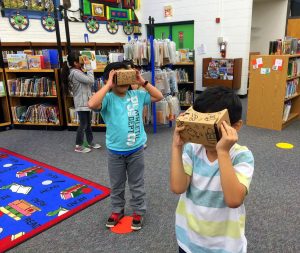
Articles
Industry News
Educating with VR Is Still Pricey, But Costs Are Dropping
By Henry Kronk
October 16, 2017
Virtual reality (VR) technology has begun to make a huge impact in education and eLearning. In Med School, numerous programs have created simple VR programs to help students learn anatomy. KFC now trains their future chefs through a VR simulation. High school students have been treated to numerous virtual field trips lately via Google Expeditions.
The technology is seeing a higher rate of adoption at the undergraduate and graduate levels of university. As experts from review paper writing services note, most universities are actively working on launching VR technology for future graduates. But most schools and institutions are still a long way off from effectively implementing VR-based education and training modules. And the challenge, in most cases, is the prohibitive cost.
The Gear You Need
Before you even start research on the right headset, you need to make sure your computer is VR-compatible. To begin, you’ll need about 8GB of RAM and a pretty hefty CPU—like Intel i5-4590 or higher.
You won’t want to skimp on your graphics card, or what’s the use? This is VR and, therefore, visually dazzling.
Off the shelf, it’s hard to find a suitable VR-compatible computer for under $1000.

The headsets aren’t cheap either. The HTC Vive retails around $600 while Facebook’s Oculus Rift sells for $400. Both these prices are down significantly from previous costs as of this summer.
For a company or institution of any size to implement a VR education program, therefore, requires a lot of overhead.
The price varies depending on several factors. To get a ballpark idea, it costs Walmart under $20,000 to install their Black Friday employee training simulation (which sounds terrifying) in a single location.
But that price is also dropping for several reasons
First, VR headsets powered by mobile phones, and not computers, have been developing at a fast pace. Mobile-powered VR headsets like Google’s Daydream View and Samsung’s Gear VR have proven themselves to be more than competent. These devices retail for $100 and $80 respectively.
In October Facebook CEO Mark Zuckerberg announced the Oculus Go, a mobile-powered version of the granddaddy which retails for $200. Some headsets, like the Mattel View-Master, can be found for as little as $20 on Amazon.
What’s more, VR sharing platforms having been popping up. Splash, Sketchfab, GoPro, and Spinnable are all hoping to be the YouTube of VR. For now, that might bog VR enthusiasts down like Aesop’s donkey caught among so many bales of hay.
But for institutions that can’t afford to generate their own VR programs and training modules, it means that the cost of virtual education could go way down.
The price of computer-powered VR is dropping too. BestBuy now offers over 150 VR-compatible computers, some of which even cost less than $1K.
As more and more companies drive competition, the technology should become more commonplace. It will become less a niche program set up by large companies and institutions that have less trouble with funding, and more something that you would expect to find in an elementary school classroom.
Google Expeditions marks a forerunner in this regard. Seeking to simulate a class field trip, they offer $15 cardboard headsets that can connect to students’ phones. The corresponding app offers virtual tours through remote, historic, or inaccessible places. One video, for example, shows a rocket launch, another brings students to shark-infested waters.
“It’s basically a personal field trip app,” says Product Manager Ben Schrom, according to CNN. “It facilitates the teacher taking his or her students on a VR trip to a place or set of different places.”
“In one class students can actively explore Machu Picchu and in the next they can explore the inside of the human bloodstream.”
The app is available to download for free on Google Play and Apple’s App Store.
Implementing Google Expeditions, however, does not come without its challenges. Even high school students can’t always be relied on to have a compatible smart phone. For the headsets, complementary software, and devices, the VR program can cost as much as $15,000.
VR technology as we know it today has only been available to the public for a few years. Efforts to implement it in eLearning are even younger. As costs fall, new, imaginative eLearning programs are sure to pop up.









No Comments